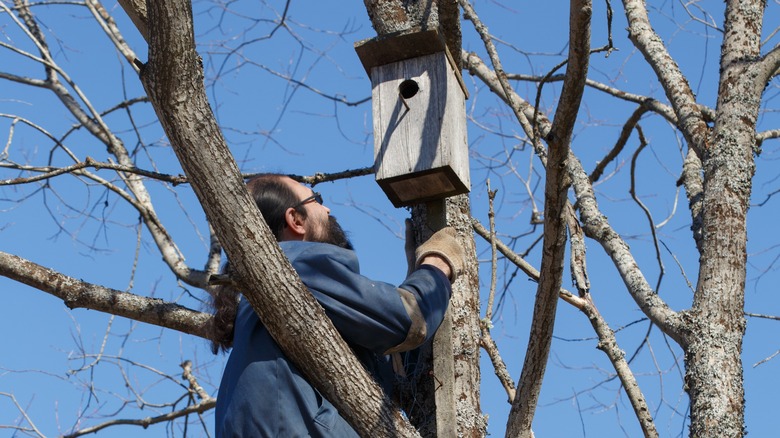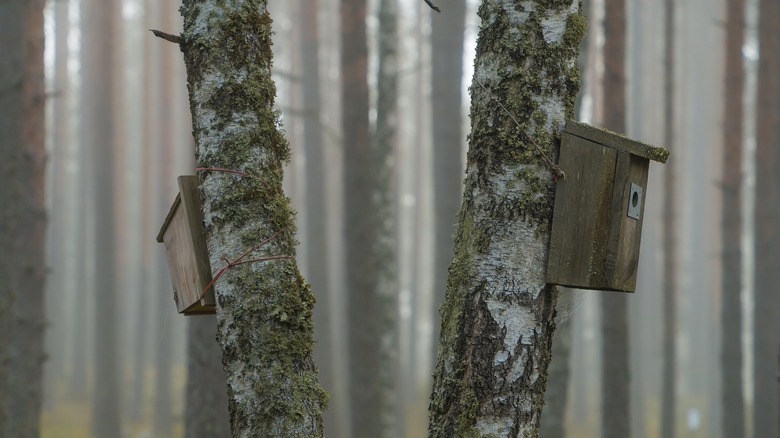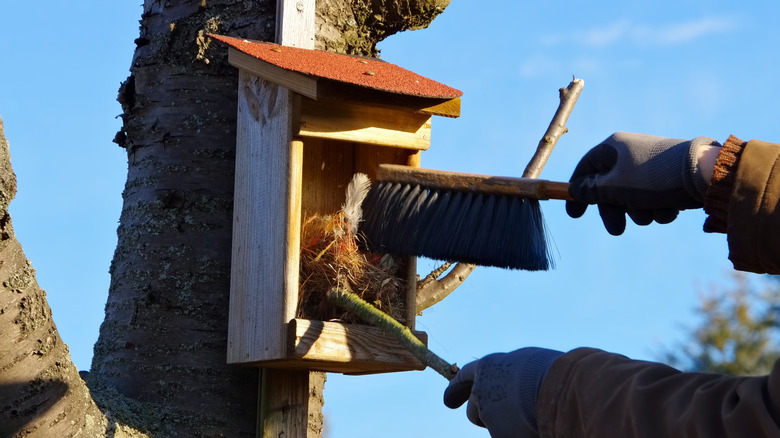Why Rushing To Install A Birdhouse May Spell Sparrow Trouble
If you've installed nestboxes for wrens, bluebirds, or tree swallows, sparrows are among the birds you do not want to be seeing in your yard. These introduced birds are small but feisty, especially the males. They'll oust other, less aggressive birds from a nest box and take up residence with their own family. Once established, it's hard to get them to leave until their chicks have flown the coop. We're not suggesting ditching the birdhouse idea entirely; you just need to do your research before rushing to install those birdhouses at the end of winter. You can use quite a few strategies to deter these feathered pests from setting up shop in a birdhouse in the first place.
House sparrows (Passer domesticus), not to be confused with native sparrows like the field sparrow, grasshopper, or golden-crowned sparrow, were introduced into the U.S. in the mid-1800s. Exactly why is murky. Some sources say they were released in New York City to control insects, while other sources claim Boston was the location, and the birds were introduced to control pest gypsy moths. Whatever the case, it turns out sparrows breed rapidly and mostly eat seeds; they quickly became agricultural nuisances and were particularly successful in urban areas. The tawny-hued adults reach 5 to 6.5 inches tall. At this size, house sparrows can fit through holes as small as one and a quarter inches in diameter — meaning almost every birdhouse entrance suits them just fine.
Using a sparrow's adaptions against it
Sparrows are aggressive toward other cavity-nesting birds and have decimated native populations in cities by attacking them at bird feeders, nesting early, or invading and fiercely defending nest sites. Although there's no scientifically proven way to deter sparrows, that doesn't mean you should give up. Sparrow bully deterrents have shown limited to promising success. Living in urban areas, where sparrows are prolific, adds to the challenge. If you're rural, your efforts may be better rewarded. Use seeds sparrows dislike in feeders, block birdhouse holes or remove boxes until late spring (most sparrows have finished nest prospecting by then; native birds are starting), and don't mount your nestbox in an area heavily populated by sparrows.
Birdhouse location, hole size, and design matter, too. First, move nestboxes into less human-frequented areas (aim for a distance of at least 300 feet) or place birdhouses an average of 10 feet from one another. If a sparrow nests in one, it will defend the other from other sparrows but not different species. If you're even a little bit handy, you can modify your existing nestbox to deter sparrows. Adding a cross of 6-pound monofilament fishing wire to the top of the house and vertical lines down the front — about a quarter to half an inch on either side of the hole and about an inch and a half out from the front of the box — will confuse sparrows, whom experts presume to have poor sight.
Less savory sparrow removal methods
Other birdhouse modifications include raising the nesting box floor to within 3 inches from the hole, installing a Sparrow Spooker (Sialis has step-by-step instructions to make one), or affixing a hole reducer. If you're in the market for the best type of birdhouse for your yard, start strong by making or buying a so-called sparrow-proof design (we say so-called because experts debate their efficacy). Try a shallow Gilbertson PVC box, Hugh's slot box (with a slit instead of a round hole), a chickadee box, a chimney swift tower, or a nesting platform. Duncraft sells a sparrow-resistant birdhouse for $69.95, and an Aspen Song sparrow-resistant wooden bluebird house goes for $36.99 at Ellington Agway.
Whichever birdhouse you choose, remember to be a welcoming feathered home host. Check your nest boxes daily for evidence of sparrows, and remove any nesting material you find. Do this until the persistent birds avoid your birdhouse. House sparrows, like starlings, are not native and live in the U.S. all year round, so the Migratory Bird Treaty Act does not protect them. This means there are other tactics — removal and harassment techniques — you can employ if nothing else works. Warning: These methods are not for everyone. Homeowners can legally remove or destroy eggs or trap birds in nest boxes and humanely euthanize them. Note, however, that sparrows aren't the only birds that will use a cavity-nesting box — protected species will, too. Positive species identification is imperative before resorting to these methods.


